Audio Note Ongaku Integrated, G70 preamp and GE-1 Phono stage
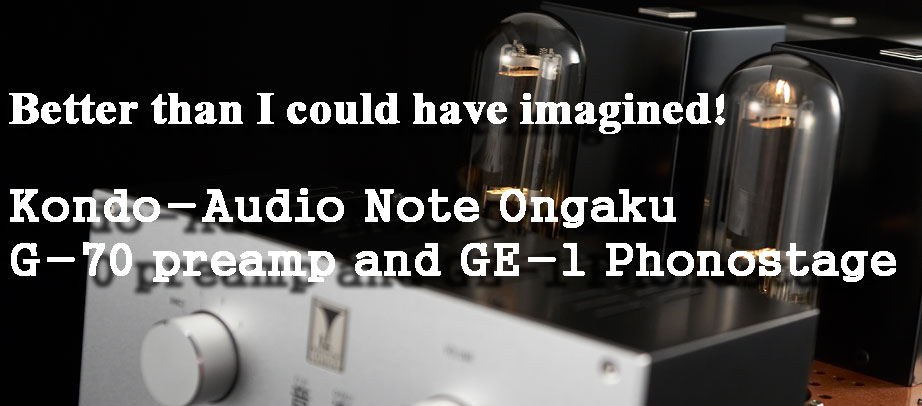

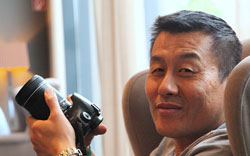 When I reviewed the Kondo-Audio Note Overture integrated amplifier last spring, I had great expectations. After listening to it in my home, I finally understood how this legend was borne.
When I reviewed the Kondo-Audio Note Overture integrated amplifier last spring, I had great expectations. After listening to it in my home, I finally understood how this legend was borne.
Here is my experience.
I’ve always had an affinity for Audio Note gear dating back to the early ’90s. My very first exposure to this Japanese brand was with the legendary Ongaku. But, what I couldn’t quite understand was why there was a big fuss about a product that offered only 27 watts per channel but was priced at nearly $100k. There were a lot of reference-caliber products out there for less money and lots more power in both tubes and solid-state amplifiers back in the day – CAT, Jadis, Audio Research, Levinson, and Krell – to name just a few. I remember reading in some foreign audio magazine about how great the Ongaku performed with an entire listening panel of reviewers. It reminded me of my first encounter with the Ongaku at CES 2003, I think, on my first visit to Las Vegas. After staring it down for a good ten minutes, I asked to hear a Haydn String Quartet recording, and, no, the sky didn’t open up, nor did I hear angels singing. But it was certainly love at first sight (or song!) This mythical beast presented the music with such lifelike timbres that it simply caught me off guard on an emotional level I had never experienced previously. Easily the closest I heard to a live performance.
My new dilemma: at $101,342.00, I still can’t even remotely afford it.
Sometime in March of this year, I was gracefully given the serendipitous opportunity to review the newest legendary Ongaku integrated amplifier. Better yet, it came with a family: the G70 preamplifier and GE-1 phono stage with MC transformer (model KSL-SFz). This was made possible by Bob Visintainer of Rhapsody Music & Cinema, who serves as Kondo-Audio Note’s sole US distributor. It’s been twenty years in the making so you can only imagine how thrilled I was to finally have the Ongaku in my listening space and under formal review.
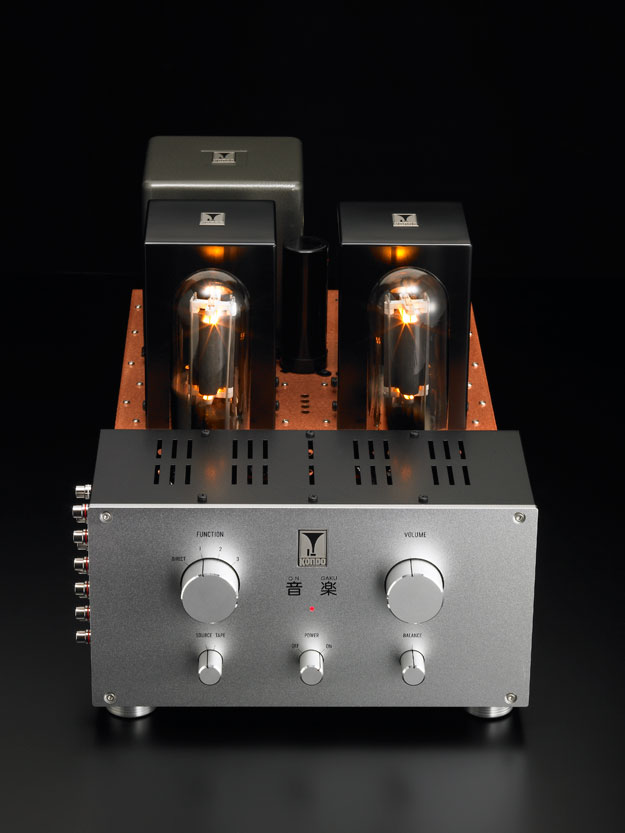
The Ongaku, which stands for “music” in Japanese, was designed by Kondo-Audio Note’s founder, Hiroyasu Kondo, in 1989 and instantly became a true legend if not for its performance, then certainly for its price/power ratio. The Ongaku attracted instant worldwide attention from the audio press and music lovers alike. Granted, its asking price was far more of a contention for some than its performance. Unfortunately, audiophiles see the price tag. Few will ever hear this design in the luxury of their own home. Even in the here and now, nearly a quarter of a century later, the fanfare surrounding the Ongaku still lives on.
The latest Ongaku is an integrated amplifier based on the same single-ended triode pure class-A design used in the original. Using a single 211 (NOS GE-VT-4-C) output tube that produces 27 watts per channel, the input tubes chosen are 2AY7/6072 types. The first input stage is driven by an SRPP (series regulated push-pull), while the second stage – using 5687 tubes – is direct signal coupled (the driver stage works as a cathode follower directly before amplification). Four GZ34s are used for a rectifier; they supply a full wave rectification for high supply voltage at 1,000V. As stated, the basic 211 circuit is still used as it was on the very first Ongaku, however, there have been many changes made to this latest series Ongaku. With 20 years plus of know-how and experience, Masaki san and his team’s dedication to improving the sound of the Ongaku has paid big dividends. Aesthetically, the Ongaku received a nice facelift while the essential innards and design have been retained. Of the notable changes worth mentioning are: the proprietary Kondo-designed copper binding posts are all silver, while the RCA jacks were changed to a custom-made silver boasting rhodium and brass as core material. In addition, about 6 years ago, internal improvements included using pure silver lead resistors, Kondo E-caps, and silk/silver wire, just to name a few. Brass and stainless steel screws are strategically used to get the best sound balance. According to Kondo-Audio Note’s president Ashizawa Masaki, “the fundamental design has not changed, but with the improvements made from generation to generation, the newest Ongaku sounds better than the first Ongaku.”
The Ongaku is machined out of high-grade aluminum to form a solid under-chassis. While the front fascia is made of shiny aluminum, the Ongaku side panels are made of pure copper. I think it’s the two-tone color that gives it that certain appeal. It’s what originally caught my eye twenty years ago, and that gives this design its legendary appearance. The layout of the front panel is elegantly simple and functional. There are five rotary knobs. There are two large knobs on top, the left is a function switch; there is a direct in and three inputs; direct input gives purer sound bypassing the source selector and the right is the Volume control. There are three smaller knobs below the two large knobs; a power on/off switch on the left below, a stereo mono switch in the middle, and a DB switch on the right below. So much detail and care went into the Ongaku that even the rotary knobs are meticulously finished so that the edges of the knobs are polished brilliantly, adding a touch of class. Input sockets on the left adjacent side are meticulously finished four sets of unbalanced (RCA) input sockets, a 5-way binding post, and an IEC plug. There are a total of four transformers used in the Ongaku. Three transformers occupy the Ongaku’s rear flank. Transformers and power supply are the backbone of tube amplifier design, and the Ongaku is renowned for its achievement in this area. Ongaku pioneered the use of silver in audio amplification, and its revolutionary Kondo silver output transformers are prime examples. This overbuilt power supply sports two power transformers (one for the main, the other is used for filament rectifiers).
Overall, I found Ongaku’s new, high-quality retro/industrial look rather impressive.
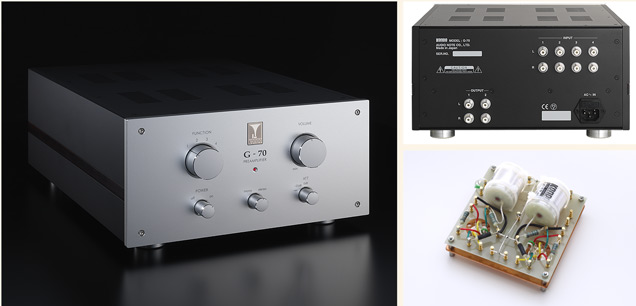
G-70 p reamplifier, GE-1 phono stage, and KSL- SFz MC transformer.
The G-70 and the GE-1 are Kondo’s new-generation preamplifiers, released late in 2010. Both were designed by Katsura Hirokawa and tuned by Ashizawa Masaki, the CEO of Kondo-Audio Note.
The G-70 is an Audio Note Kondo’s most affordable linestage preamplifier at a cool $33,968. The circuit design is rather simple and is a mini-version of their new flagship M1000MKII preamplifier with a built-in power supply. The G-70 uses two Electro Harmonix 6072 dual-triode tubes and one NOS GE 6×4 is used for rectifier. Its design secret lies in the materials and matching of the components. There are new concepts in the design, such as a new power supply design and a DC heater circuit and module assembly style, which improves sound performance and stability. There is a robust power supply section with a huge reservoir combining three types of capacitors in the left and right channels. This delivers natural and stress-free music over the entire frequency bandwidth. The G-70 uses the same high-quality volume control as the M7/Line preamplifier, a high-precision Apls HQPro volume control. Custom-made transformers and chokes are produced by ISO Tango.
The G-70 is a single box, finished simple and elegantly. In my hand, it feels like a superbly made product. The high-quality handcrafted module-style line amplifier utilizes strategically placed components, signal wiring, and ground layout. Ultra-high quality custom-made parts are used throughout, featuring a meticulously crafted chassis. Like the Ongaku, it sports a shiny aluminum faceplate and side panels, while the rest of the chassis is made of copper. A thin strip of rosewood is inlaid alongside the side panels for what the designer says to improve its sound. The G-70’s front panel is quite similar to the Ongaku. It employs five rotary knobs, with two large rotary knobs on top, a function selector knob on the left side with four inputs, and volume control on the right side. There are three smaller knobs below a power on/off knob on the left, a stereo/mono knob in the middle, and an ATT (volume) knob on the right. On the back of the G-70, there are four sets of exquisitely finished, high-quality RCA inputs and two sets of RCA outputs, and on the left bottom is the IEC plug. The chassis sports a well-ventilated top cover.
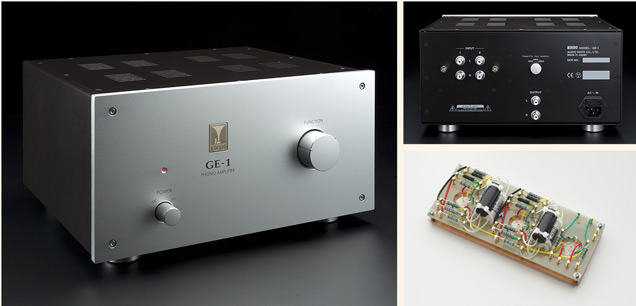
The GE-1 is the new generation phono stage designed to be a companion for the Overture integrated amplifier and G-70. The same quality abounds: silver wiring through and through, handmade silver foil capacitors, resistors, and two-tone metal chassis are used in the GE-1. The newly developed phono stage circuitry employs a massive power supply section and uses an NFB-type RIAA circuit. The GE-1 uses three Electro-Harmonix 6072 dual-triode tubes, and the output circuit has two gain stages, an NF plus cathode-follower for the final stage, and an input-impedance selector switch- with a choice of 20, 50, and 100k ohms is provided. The power supply of the GE-1 utilizes a cut core power transformer with minimal magnetic flux leakage and it is adapted to provide the best foundation for the finest sound quality and features a 6×4 rectifier tube. A ripple filter capacitor (400uf) and decoupling capacitors (about 500uf/ch) are laid out in the best circuit positions. The decoupling capacitors for right and left are also placed independently for the cathode follower and equalizer sections. The audio grade TO3 type transistors are employed at the DC heater circuit to ensure powerful ripple rejections and stability against voltage fluctuation. This results in a low-impedance DC line and a high purity of sound. The GE-1 is designed to be used with a step-up transformer for better S/N due to passive amplification. Using the SUT helps not only to make the circuit simpler but also makes for improved sound quality says its design team.
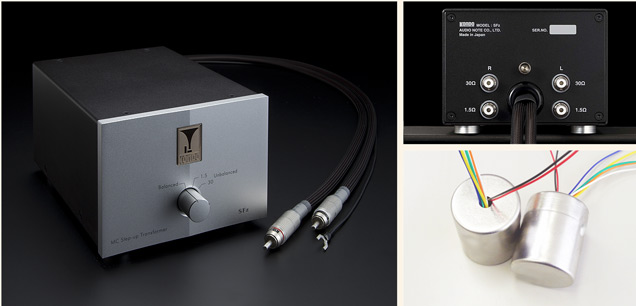
The KSL- SFz silver step-up transformer is based on Kondo’s silver wire application. Over 30 years of experience in transformer winding and an understanding of wire diameter enable the Audio Note Kondo engineering team to fully exploit the excellent sound characteristics of pure (99.99%) silver. A custom-made, high-quality, ultra-thin permalloy core suppresses the eddy current loss, and a multi-layer winding structure is used to maintain flat frequency response up to 100 KHz.
All of Kondo’s parts are meticulously selected after many hours of listening tests in their listening room. They really take their time to research and develop a product before bringing it to market. It’s a painstaking process. Masaki san and his team are perfectionists who are very passionate and proud of their work. The silver wire output transformer and power transformer have been wound by hand by skilled artisans. All conducting materials are pure silver, which suppresses unwanted vibration; natural silk is used and twisted around the silver conductors. As in all Kondos, this serves as an insulating layer between the silver wires and the exterior PVC jacket. The extraordinary Audio Note Kondo handmade silver foil capacitors are used throughout. They are specially designed to prevent potential oscillation, which could easily generate a muddy sound when the signal surges from low to high level. Every detail is meticulously thought out.
Ongaku equals Music: make no mistakes about that!
One sunny weekend in April Bob Visintainer hand delivered the Ongaku, the G70, and the GE-1 and KSL-SFz along with Kondo’s silver cables. Setting up the arsenals was straightforward; I used Kondo silver cables and my reference Jorma Design Unity cables throughout the system, and, from time to time, I used the beautiful-sounding Onda Systems Riptide cables. I did my listening with Ongaku by itself as an integrated amplifier first; then, most of my listening was done with the G-70 as a tag team.
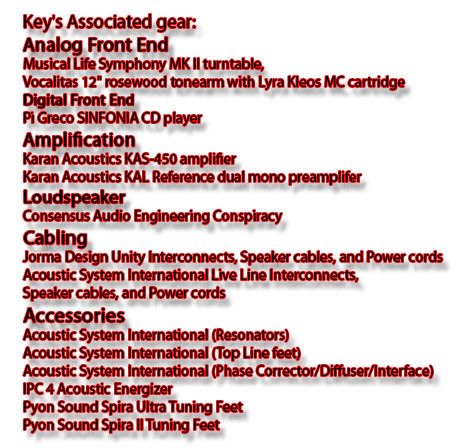 I was extremely excited to finally get to hear the Ongaku in my reference system. I was like a kid in a candy store full of great Kondo gear. From the very first notes, I knew that the Kondo-Audio Note gear was something unusual. Kondo gear delivered what can only be described as “magical” musical enjoyment, easily living up to its name, “Ongaku.” Voices and instruments sounded so tangible with this level of purity of timbre. I don’t recall having heard of any design (either tube or solid-state) that quite competes. The music, no matter the source or genre, flowed with effortless liquidity. The reproduction of the subtlest musical nuances and slightest details had come to full bloom right before me in a way I hadn’t heard before. Finally, I understood the reason for the glorious 27 watts of pure Class-A. There’s a huge difference between power and finesse. What every other amplifier I have heard offers up is lots of power with some finesse. The Ongaku is the only amplifier I know of that offers the complete opposite: It offers up some power with an absolutely astonishing amount of finesse. Duly noted, the Ongaku had no problem driving my 91 dB Conspiracy loudspeakers to respected volumes when necessary
I was extremely excited to finally get to hear the Ongaku in my reference system. I was like a kid in a candy store full of great Kondo gear. From the very first notes, I knew that the Kondo-Audio Note gear was something unusual. Kondo gear delivered what can only be described as “magical” musical enjoyment, easily living up to its name, “Ongaku.” Voices and instruments sounded so tangible with this level of purity of timbre. I don’t recall having heard of any design (either tube or solid-state) that quite competes. The music, no matter the source or genre, flowed with effortless liquidity. The reproduction of the subtlest musical nuances and slightest details had come to full bloom right before me in a way I hadn’t heard before. Finally, I understood the reason for the glorious 27 watts of pure Class-A. There’s a huge difference between power and finesse. What every other amplifier I have heard offers up is lots of power with some finesse. The Ongaku is the only amplifier I know of that offers the complete opposite: It offers up some power with an absolutely astonishing amount of finesse. Duly noted, the Ongaku had no problem driving my 91 dB Conspiracy loudspeakers to respected volumes when necessary
Thankfully, Bob Visintainer had assured me the burn-in was done in his shop prior to their arrival here. All that was needed from me was about a half-hour warm-up to sound their best. Recording? You know, I put on Haydn’s string quartet in D major, op. 64 N0. 5 “The Lark” (DG 423 622-2) as my first. It was rendered just as exquisitely as in my first encounter 10 years ago. The Kondo gear performs magically in again, in a most natural and organic way. Strings take on a more sophisticated feel that imbues far more realism. This quartet is as layered as it is dense and resolute, making even my reference Karan seem a touch less real and rough when it counts the most. The Kondo sound is more free of mechanical artifacts than any other product I have had the liberty to audition. The Ongaku simply is the most convincing and life-like sounding amplifier that I have ever heard. The overall character, or lack thereof, of the Kondos is purity and intimacy. For it has no other character or coloration that I can think of. On the other hand, the Kondo gear makes everything else I have in-house sound colored by comparison. The Kondos are masters at digging into and thus revealing layers upon layers of details I never knew existed. Listening sessions were getting longer and longer rather than shorter and shorter.
Masaki san recommends pairing the Ongaku with the G-70 preamplifier to even further enhance its quality. As great as the Ongaku sounds on its own as an integrated amplifier, once you add the G-70 to the equation, incredibly – as hard as it is to believe – the G-70 takes the Ongaku up another notch. The G-70 gives the Ongaku more drive, improves dynamic expression, and adds vividness. Incredibly, with the G-70 in my reference system, the sound improved in every way. Considering the experience I had with the Ongaku, I was not surprised the G-70 had neither the characteristics of a tube nor a solid-state device: it sounded more like the “proverbial wire with gain.”
Ordinarily, I don’t like to use the term neutral because all audio playback is colored one way or another. I was surprised to find the G-70 to be this neutral sounding, considering it is a tube design. As of my writing this, I am still trying to find its sonic footprint. As it stands now, the only thing that may reveal it will be a more advanced version of the same design with the same name perhaps. Using the G-70 to drive my Karan amplifier revealed a more open and transparent sound that rendered the music with more grace, purity, and naturalness. The Karan is a no-slouch preamplifier design that never shied away from formidable top designs such as ASI, Concert Fidelity, and Reimyo, both of which I was fortunate to review in the past year. The G-70 is very similar to the ASI Liveline, a solid-state design I reviewed recently. Both the G-70 and the Liveline hold high marks for their respective level of purity, detail, and transparency. As far as my rig is concerned, they’re the best preamps I’ve heard thus far, and I could easily be happy with either one. At this level of performance, there is no right or wrong. It would depend on personal preference, budget, and system matching. However, I personally would tend to want at least one tube in my system. And though I could never detect any tube coloration, I do think the overall width and depth of the soundstage, not to mention dynamics, are slightly more emphasized through the tubed G-70.
In fact, this Kondo combo’s effect on my system’s spatial performance was the best I have heard. I put on one of my favorites, Dvorak’s Cello Concerto for Cello and Orchestra in B minor, op. 104(DG 139044) performed by the master, Mstislav Rostropovich, and the maestro, Herbert von Karajan, conducting Berliner Philharmoniker. Both the soundstage and the sense of space were enhanced with nary a hint of exaggeration whatsoever. I prefer a big soundstage, and the Kondo combo provided the most three-dimensional and picturesque one I could have imagined. Kondo’s portrayal of individual images is exemplary, revealing layers of small detail and nuance that I’d not previously heard. What’s more, I was able to see deep into the hall and detect instruments at the back of the stage just as vividly as those in the front. Once again, it was a musical epiphany I experienced.
Voices, in particular, were distinctly more realistic and three-dimensional.
One evening, I was in the mood for a female vocalist. Who better to enjoy than I put on than Sarah Vaughan and her fabulous recording of “You’re Blasé” (Pablo Records 2650-101). From the very first note of her voice, I knew I was in for a treat. I poured a glass of Bordeaux, sat back, and just rejoiced. I have listened to this recording many times in both vinyl and CD formats. I was lucky to find the vinyl boxed set a couple of years ago. The Kondo electronics have an ethereal way of conveying music with a more convincing illusion of live instruments. I was startled – first by the immediacy and solidity of the vocal imagery, then by the complexity of Sarah’s phrasings. Listening to vinyl with the GE-1 adds a touch more shimmer and life than my reference Karan phono preamplifier. Her soulful style, sensual persuasions, and emotional vocals touched me as if I were hearing her again for the very first time. Hard to believe. Sarah’s voice, alongside a fine set of musicians, sounded exceptionally genuine in tonality through the Kondo. This gear has no favorite genre when it comes to reproduction. The amazing lack of grit and grain that you’d come to expect from this dated recording was lessened dramatically. This led to an improved sense of clarity and intonation that I had never heard previously from Sarah. It was as if veils were lifted all at once from this dated recording. The Kondo created a startling sense of “nothingness” between myself and the music over and over again. Yet, it provides the proper sense of weight and solidity to the music, presenting Sarah as real and as captivating as I have ever heard her. The Kondos are masters at drawing you in and taking your soul hostage. The way they reproduce the (near) full scale and drama of full orchestral crescendo with such ease and grace while at the same time preserving a vocalist’s performance is truly revelatory.
Frankly, after about six weeks of living day in and day out with this level of sonic excellence, I’m pretty certain this Kondo gear makes all electronics sound somewhat thicker and more opaque by comparison.
Well, there you have it.
Living with the Kondo-Audio Note gear has been the most refreshing and exciting departure from high-end audio I have taken, for this was much more about music than audio reviewing. My world has been turned upside down as a result. I’ve learned musical enjoyment has not nearly as much to do with power and specs as it has to do with purity, beauty and grace. Masaki san and his team are true perfectionists at ebbing out these incredibly rare sonic attributes. I’ve been on the most enthralling musical journey of my reviewing career thus far and never even saw it coming. Kondo-Audio Notes are a truly remarkable achievement in design. As far as I’m concerned, they have set a pretty high benchmark for all others to be measured against. Sonically speaking, the Kondo gear is so good that it did something you can never put a price tag on: it touched my soul with an emotion I personally didn’t know was there. I never thought or believed 27 watts of purity could do what 500 watts of power could not. If this reads more like a love note than a review, you will get no apologies here. I am smitten. I tried desperately not to fall under Kondo’s magical spell. Now, unfortunately, I cannot afford this product, and it has to go back. My new official residence is audio purgatory!
Hats off to Masaki san and his team for creating these remarkable components. Highly recommended regardless of cost.


key kim
Specifications:
Ongaku – $101,342
Product 211 single ended stereo amplifier
Rated Power 27W + 27W @1kHz, 5% THD
Frequency Response 8Hz ~ 21kHz (+0dB, -3dB @1W)
Input / Impedance 4pairs (RCA, unbalanced) / 100kΩ
Output speaker (8Ω), REC OUT 1pair
Noise Less than 1mV
Vacuum tube 211 x2, 6072 x2, 5687 x2, GZ34 x4
Power consumption 330W
Dimension 284mm(W) 240mm(H) 550mm(D)
(excluding protrusions)
Weight 34kg
G-70 – $33,968
Product Stereo line preamplifier
Frequency Response 10Hz ~ 240kHz (+0dB -3dB, with 100kΩ load)
Gain 25dB
Input / Impedance 4pairs(RCA, Unbalanced) / 100kΩ
Output 2 pairs (RCA, minimum 20kΩ load)
Noise lower than 0.15mV
Tubes 6072 x2, 6X4 x1
Power consumption 21W
Dimension 303mm(W) 160mm(H) 438mm(D)
(Excluding protrusions)
Weight 17.5kg
GE-1 – $12,366
Product Stereo phono amplifier
RIAA Declination ±0.5dB (30Hz-20kHz, Excluding LCF)
Gain 34dB
Input / Impedance 2pairs (RCA, unbalanced) / 47kΩ
Output 1pair (RCA)
Noise less than 0.5mV
Tubes 6072 x3, 6X4 x1
Power consumption 16W
Dimension 303mm(W) 160mm(H) 260mm(D)
(Excluding protrusions)
Weight 7.5kg
KSL-SFz – $9,048
The primary-side impedance – 1Ω, 3Ω, 40Ω
The secondary side impedance – 4kΩ
Step-up ratio – 36dB (1Ω), 30dB (3Ω), 20dB (40Ω)
Load impedance – 47kΩ is recommended
(Not including protruding parts) Dimensions – 114mm (W) 150mm (H) 175mm (D)
Weight – 3.2kg
USA Distributor: Rhapsody Music & Cinema
Address: 27 W 24th St # 506, New York, NY 10010
Phone:(212) 229-1842
Website: www.rhapsodycinema.com
One thought on "Audio Note Ongaku Integrated, G70 preamp and GE-1 Phono stage"
Leave a Reply
Stereo Times Masthead
Publisher/Founder
Clement Perry
Editor
Dave Thomas
Senior Editors
Frank Alles, Mike Girardi, Russell Lichter, Terry London, Moreno Mitchell, Paul Szabady, Bill Wells, Mike Wright, and Stephen Yan,
Current Contributors
David Abramson, Tim Barrall, Dave Allison, Ron Cook, Lewis Dardick, John Hoffman, Dan Secula, Don Shaulis, Greg Simmons, Eric Teh, Greg Voth, Richard Willie, Ed Van Winkle, Rob Dockery, Richard Doron, and Daveed Turek
Site Management Clement Perry
Ad Designer: Martin Perry





Yasuhiro was. very kind with me! I use his silver Preamp in Marbella ,Spain